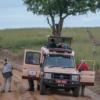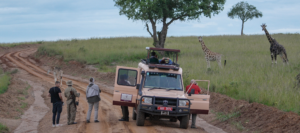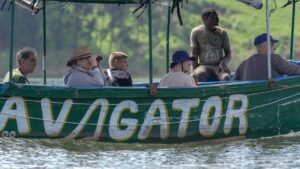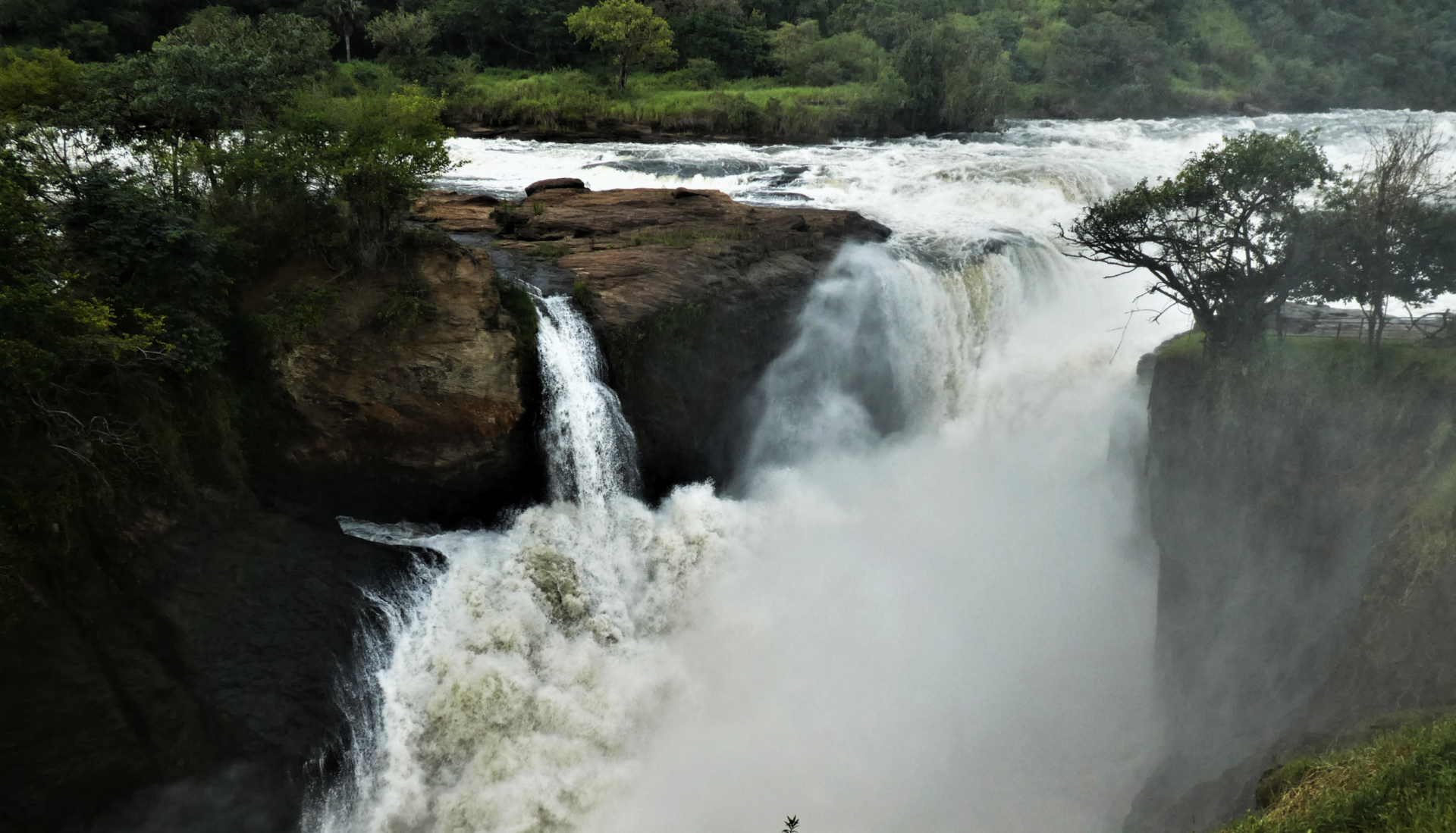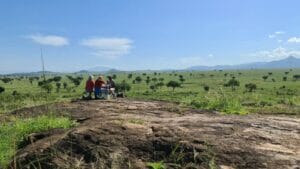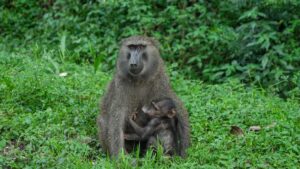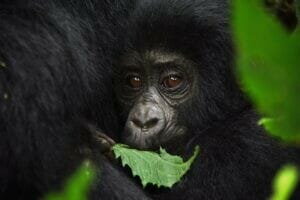Imagine embarking on a once-in-a-lifetime adventure, deep in the heart of Africa’s lush rainforests, where you have the incredible opportunity to encounter one of the world’s most fascinating creatures—the majestic gorillas. Gorilla trekking in Africa offers a unique and awe-inspiring experience that allows you to witness these gentle giants in their natural habitat, forming an indelible connection with the natural world.
- What is Mountain Gorilla Trekking?
- Why Mountain Gorilla Trekking in Africa?
- Where Can You Go Mountain Gorilla Trekking in Africa?
- Conservation Efforts for Gorillas in Africa
- Importance of Responsible Tourism in Gorilla Trekking
- Planning Your Gorilla Trekking Adventure
- Booking Permits for Gorilla Trekking
- Accommodation Options for Gorilla Trekking Tours
- Safety Guidelines and Regulations During Gorilla Trekking
- Cultural Sensitivity and Etiquette When Interacting with Gorillas
- The Gorilla Trekking Experience: What’s The Day Like?
- Gorilla Habituation vs. Gorilla Trekking: What’s the Difference?
- Gorilla Trekking Routes and Difficulty Levels
- What to Expect During a Gorilla Trekking Day
- Interacting with Gorillas: Behavior, Communication, and Social Structure
- Potential Challenges and Risks During Gorilla Trekking
- Other Wildlife Experiences and Attractions in Africa
- Cultural Experiences and Local Communities in Gorilla Trekking Destinations
- Sustainable Tourism Initiatives in Gorilla Trekking Areas
- Book Your Mountain Gorilla Trekking Tour With Kikooko Africa Safaris
What is Mountain Gorilla Trekking?
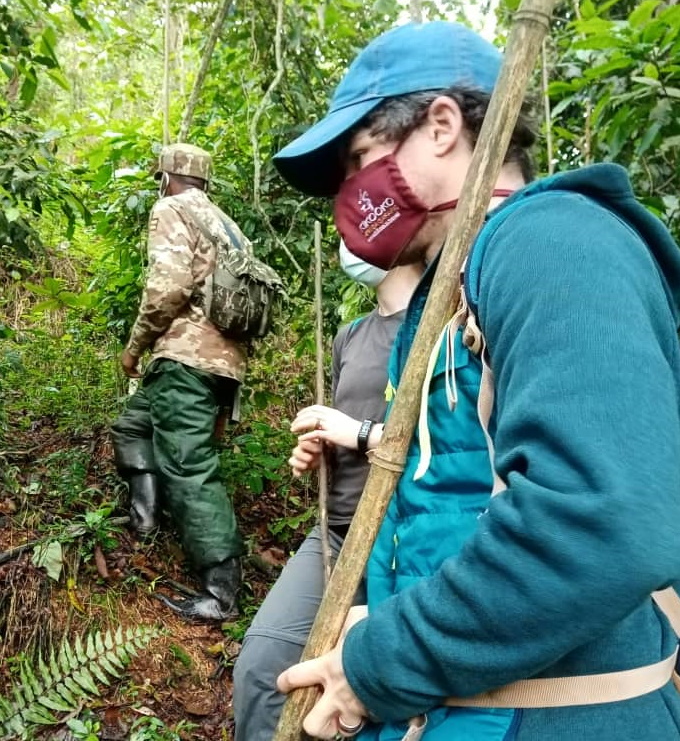
Gorilla trekking refers to the thrilling activity of venturing into the remote corners of Africa’s dense forests in search of habituated gorilla families. This immersive experience enables you to observe these captivating primates up close, witnessing their social interactions, behavior, and the intricate dynamics of their family groups. It’s a chance to witness their astounding strength, intelligence, and striking resemblance to our own species.
Why Mountain Gorilla Trekking in Africa?
Africa is home to two species of gorillas—the endangered mountain gorillas and the critically endangered western lowland gorillas. With populations dwindling due to habitat loss, poaching, and disease, gorilla trekking not only offers an unforgettable adventure but also serves as a vital means of conservation. By participating in gorilla trekking tours, you contribute directly to the protection of gorillas and the preservation of their habitats, ensuring their survival for future generations.
Where Can You Go Mountain Gorilla Trekking in Africa?
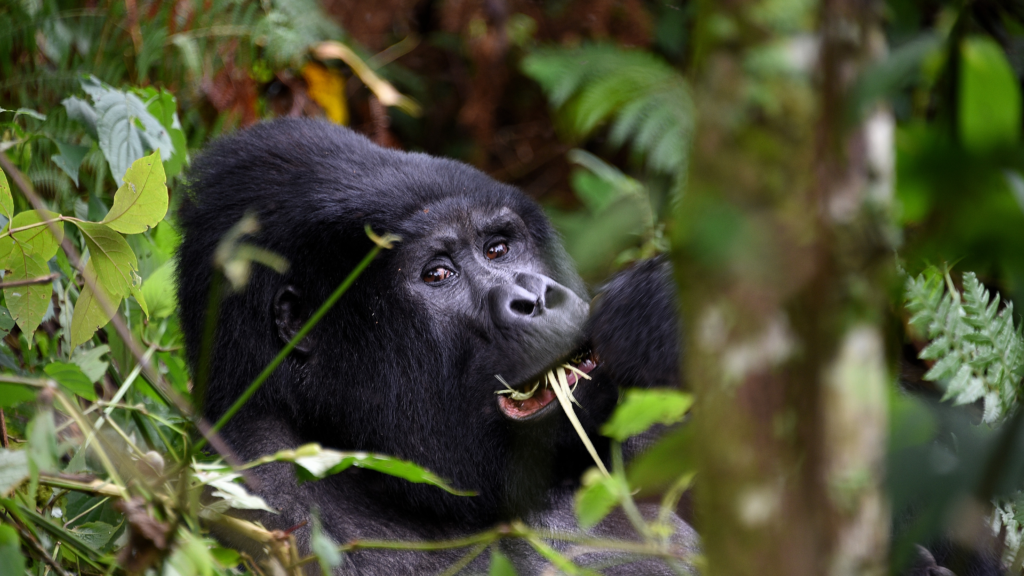
Gorilla trekking is primarily conducted in three countries within Africa: Uganda, Rwanda, and the Democratic Republic of Congo (DRC). Each destination provides a unique experience and different opportunities to encounter gorillas in their natural environment.
Uganda:
Known as the “Pearl of Africa,” Uganda boasts two national parks that offer gorilla trekking experiences: Bwindi Impenetrable National Park and Mgahinga Gorilla National Park. These parks are home to almost half of the world’s mountain gorilla population, making Uganda an ideal destination for those seeking an authentic and immersive gorilla encounter.
Rwanda:
Rwanda, often referred to as the “Land of a Thousand Hills,” is renowned for its commitment to conservation and gorilla tourism. Volcanoes National Park, located in the Virunga Mountains, is Rwanda’s primary gorilla trekking destination. This extraordinary park provides a picturesque backdrop for your gorilla adventure, offering breathtaking views of volcanic peaks and lush landscapes.
Democratic Republic of Congo (DRC):
The DRC is a lesser-known gem for gorilla trekking, with Virunga National Park being the prime destination. While the country has faced political challenges, it remains a significant stronghold for gorilla conservation. Virunga National Park is home to both mountain gorillas and eastern lowland gorillas, providing a unique opportunity to encounter two distinct species in one location.
Conservation Efforts for Gorillas in Africa
Gorilla trekking not only offers an enchanting encounter with these remarkable creatures but also plays a crucial role in their conservation. Across Uganda, Rwanda, and the DRC, dedicated conservation organizations and park authorities work tirelessly to protect gorillas and their habitats. These efforts include anti-poaching initiatives, habitat restoration, community development projects, and education programs aimed at raising awareness about the importance of gorilla conservation.
Importance of Responsible Tourism in Gorilla Trekking
As visitors, it is essential to approach gorilla trekking with a sense of responsibility and respect for both the gorillas and their environment. Responsible tourism practices, such as following strict guidelines and regulations, maintaining a safe distance from the gorillas, and minimizing our ecological footprint, are imperative to ensure the long-term sustainability of gorilla tourism. By adhering to these principles, we can contribute to the preservation of these magnificent creatures and the fragile ecosystems they inhabit.
In the following sections, we will delve deeper into the planning process for your gorilla trekking adventure, including the best time to go, choosing the right destination, booking permits, necessary fitness requirements, and essential gear. We will also explore what to expect during your gorilla trekking experience, including the behavior and social structure of gorillas, potential challenges, and safety guidelines. Additionally, we will highlight other wildlife experiences and attractions in Africa, as well as sustainable tourism initiatives in gorilla trekking areas.
Prepare yourself for an unforgettable journey as we embark on an in-depth exploration of gorilla trekking in Africa—a truly transformative experience that will leave you with memories to cherish for a lifetime.
Planning Your Gorilla Trekking Adventure
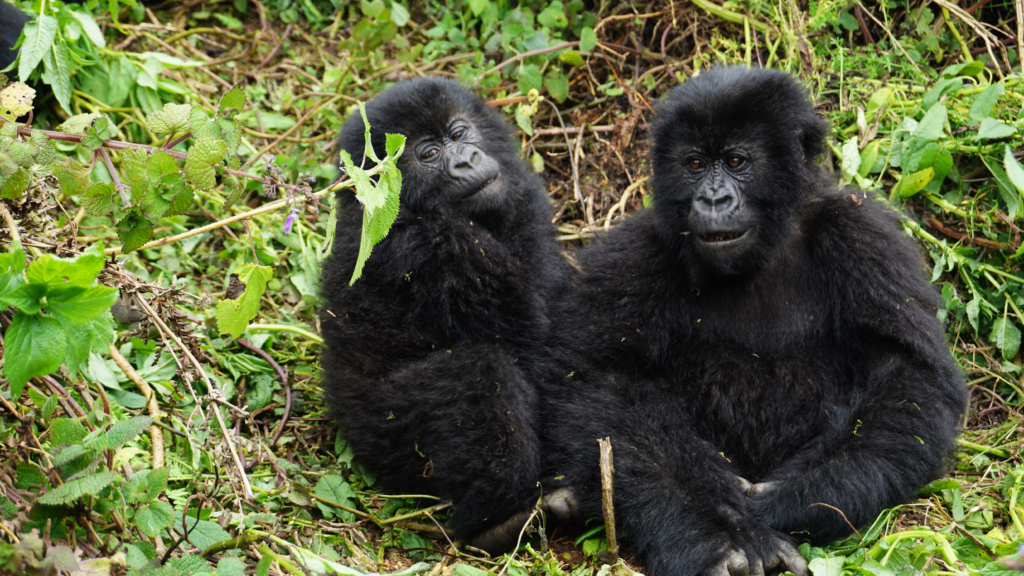
Embarking on a gorilla trekking adventure requires careful planning to ensure a seamless and memorable experience. From choosing the right time to go and selecting the ideal destination to booking permits and arranging accommodations, each step plays a crucial role in shaping your gorilla encounter. In this section, we will delve into the essential factors to consider when planning your gorilla trekking adventure in Africa.
Best Time to Go Gorilla Trekking in Africa
The timing of your gorilla trekking expedition is essential, as it can greatly impact your overall experience. While gorilla trekking is possible throughout the year, certain seasons offer more favorable conditions for optimal sightings and trekking conditions.
The dry seasons, typically occurring from December to February and June to September, are considered the best times to go gorilla trekking. During these periods, rainfall is minimal, making the trails more accessible and increasing the chances of encountering gorillas.
How to Choose the Right Destination for Gorilla Trekking
Africa offers multiple destinations for gorilla trekking, each with its own unique advantages and characteristics. Uganda, Rwanda, and the Democratic Republic of Congo (DRC) are the primary countries that provide gorilla trekking opportunities. When choosing your destination, consider factors such as the size of the gorilla population, trekking difficulty, availability of permits, cost, and the overall experience you desire.
Uganda, known as the “Pearl of Africa,” is home to almost half of the world’s mountain gorilla population. Bwindi Impenetrable National Park and Mgahinga Gorilla National Park are the two main parks in Uganda for gorilla trekking. Bwindi Impenetrable National Park, a UNESCO World Heritage site, boasts a rich biodiversity and offers a more challenging trekking experience. Mgahinga Gorilla National Park, situated in the Virunga Mountains, provides an opportunity to trek gorillas within a stunning volcanic landscape.
Rwanda, often referred to as the “Land of a Thousand Hills,” is renowned for its commitment to gorilla conservation. Volcanoes National Park, located in the Virunga Mountains, is Rwanda’s primary gorilla trekking destination. The park offers breathtaking views and a relatively easier trekking experience compared to other destinations.
The Democratic Republic of Congo (DRC) is a lesser-known but equally captivating destination for gorilla trekking. Virunga National Park in the eastern part of the country is home to both mountain gorillas and eastern lowland gorillas. Unfortunately, it is not currently available for gorilla trekking tours.
When choosing your destination, consider factors such as accessibility, budget, and any specific preferences you may have, such as combining gorilla trekking with other wildlife experiences or cultural encounters.
Booking Permits for Gorilla Trekking
Obtaining permits is a crucial step in planning your gorilla trekking adventure. Permits are required to enter the national parks and spend a designated amount of time with the gorillas. Due to the limited number of permits issued each day to ensure the gorillas’ well-being, it is advisable to book your permits well in advance.
The process of securing permits varies depending on the country and park you choose. In Uganda, permits can be obtained through the Uganda Wildlife Authority (UWA) or authorized tour operators. In Rwanda, permits are issued by the Rwanda Development Board (RDB), and in the DRC, permits can be obtained through the Institut Congolais pour la Conservation de la Nature (ICCN) or authorized tour operators.
It is essential to be aware of the permit fees, which can vary between countries and even within different parks. These fees contribute to gorilla conservation efforts and the local communities surrounding the parks. By obtaining permits and paying the associated fees, you directly contribute to the long-term protection of gorillas and their habitats.
Accommodation Options for Gorilla Trekking Tours
Choosing the right accommodation is another critical aspect of planning your gorilla trekking adventure. Each destination offers a range of lodging options, from luxury lodges to budget-friendly accommodations, ensuring that there is something suitable for every traveler’s preferences and budget.
In Uganda, you can find a variety of accommodations near Bwindi Impenetrable National Park and Mgahinga Gorilla National Park, ranging from eco-lodges to luxury safari lodges. These accommodations provide comfortable amenities and often offer stunning views of the surrounding landscapes.
In Rwanda, accommodations near Volcanoes National Park cater to different budgets and preferences. From luxurious lodges to charming guesthouses, you can find options that suit your needs while providing easy access to the park for your gorilla trekking adventures.
When selecting your accommodation, consider factors such as proximity to the park, amenities offered, customer reviews, and the overall experience you desire. It is advisable to book your accommodations well in advance, as availability can be limited during peak seasons.
Safety Guidelines and Regulations During Gorilla Trekking
Responsible tourism and safety guidelines are of utmost importance during gorilla trekking to ensure the well-being of both visitors and the gorillas. Here are some essential safety guidelines to adhere to:
- Follow Your Guide: Always listen to and follow the instructions of your experienced guide. They are well-versed in gorilla behavior and will ensure your safety throughout the trek.
- Maintain Distance: Respect the recommended distance between you and the gorillas. Keeping a minimum distance of 7 meters (23 feet) helps minimize stress and prevents the transmission of diseases.
- Don’t Touch the Gorillas: While it may be tempting, refrain from touching or making any physical contact with the gorillas. This helps maintain their wild behavior and prevents potential harm to both parties.
- Keep Quiet: Speak softly and avoid making sudden loud noises that could startle the gorillas. This helps maintain a calm and peaceful environment for the gorillas and allows you to observe their natural behavior.
- Do Not Eat or Drink Near the Gorillas: Eating or drinking in close proximity to the gorillas can provoke their curiosity and potentially create dangerous situations. It is essential to follow the guidelines provided by your guide regarding food and drinks.
- Do Not Litter: Respect the environment and ensure that you carry out all trash and waste. Leaving a clean and pristine environment helps preserve the natural habitat of the gorillas.
Cultural Sensitivity and Etiquette When Interacting with Gorillas
Respecting the local culture and observing proper etiquette when interacting with gorillas is essential. Here are some cultural sensitivity guidelines to keep in mind:
- Dress Appropriately: Dress modestly and respectfully when visiting local communities near the gorilla trekking destinations. Follow any specific dress codes or guidelines provided by your guide.
- Ask Permission for Photography: If you wish to take photographs of local communities or individuals, always ask for permission first. Respect their privacy and cultural beliefs.
- Observe and Learn: Take the time to observe and learn about the local customs and traditions. Engage respectfully with the local communities, showing appreciation for their way of life.
By following these safety guidelines and cultural sensitivities, you can ensure a respectful and responsible gorilla trekking experience that benefits both the gorillas and the local communities.
The Gorilla Trekking Experience: What’s The Day Like?
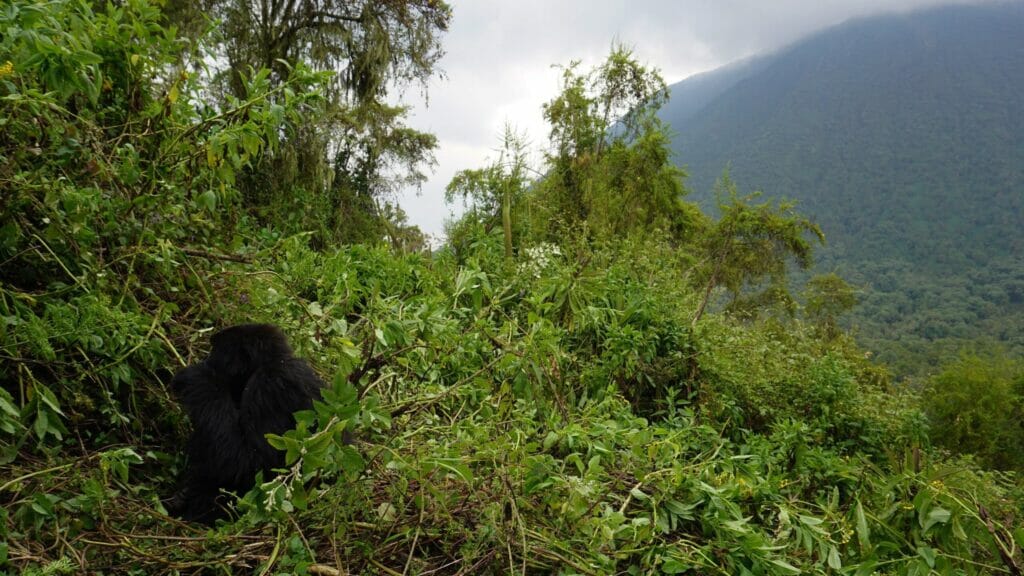
The moment has arrived—the day you embark on a thrilling and unforgettable gorilla trekking experience. In this section, we will delve into what you can expect during your gorilla trekking day, including the different trekking routes and difficulty levels, the behavior and social structure of gorillas, potential challenges, and safety guidelines.
Gorilla Habituation vs. Gorilla Trekking: What’s the Difference?
Before we dive into the gorilla trekking experience, it’s essential to understand the distinction between gorilla habituation and gorilla trekking. Gorilla habituation involves spending an extended period with a gorilla family that is in the process of being habituated to human presence. This immersive experience allows researchers and conservationists to closely study and monitor gorilla behavior. Gorilla habituation experiences are usually longer and more expensive.
On the other hand, gorilla trekking involves visiting a habituated gorilla family that is accustomed to human presence. Treks typically last a few hours, allowing visitors to observe and photograph the gorillas in their natural habitat. Gorilla trekking offers a unique opportunity to encounter these magnificent creatures up close, while still respecting their wild nature.
Gorilla Trekking Routes and Difficulty Levels
Gorilla trekking routes vary depending on the destination and the specific gorilla families being visited. Each trekking route offers a unique experience, from dense forests to open clearings, and varying levels of difficulty. Here are some examples of popular gorilla trekking routes:
- Bwindi Impenetrable National Park, Uganda: Bwindi Impenetrable National Park offers several trekking routes, each providing a different experience. The routes include Buhoma, Ruhija, Rushaga, and Nkuringo. Some routes involve steeper terrains and longer treks, while others offer more moderate options. The difficulty level will depend on the specific route chosen and the trekking conditions on the day of your visit.
- Volcanoes National Park, Rwanda: Volcanoes National Park features several gorilla trekking routes, including Sabyinyo, Susa, Amahoro, Kwitonda, and Hirwa. The difficulty level of these routes can vary, with some treks involving steeper climbs and longer distances. The park authorities and guides will assess the fitness level of visitors and assign them to appropriate groups based on their capabilities.
When choosing your trekking route, it is important to consider your fitness level, preferences, and any physical limitations. Communicate openly with your tour operator or guide, who will help you select a route that suits your capabilities and desires.
What to Expect During a Gorilla Trekking Day
On the day of your gorilla trek, you will rise early in anticipation of the adventure ahead. After a hearty breakfast, you will meet your guide and fellow trekkers and receive a briefing on the rules and regulations to ensure a safe and respectful experience. The guide will provide information about the specific gorilla family you will be visiting, their behavior, and any particular guidelines for the trek.
Once the briefing is complete, you will embark on your trek into the heart of the forest. The duration of the trek can vary, ranging from one to several hours, depending on the location of the gorilla family and the terrain. As you make your way through the lush vegetation, your guide will lead you along narrow trails, pointing out interesting flora and fauna along the way.
When you approach the gorilla family’s location, you will leave your backpacks and any unnecessary gear behind and proceed quietly and cautiously. The moment you encounter the gorillas face-to-face is truly awe-inspiring. You will have a designated amount of time to observe, photograph, and immerse yourself in the mesmerizing presence of these gentle giants.
During this time, you will witness the gorillas’ social interactions, observing their behavior and the dynamics within the family. You may see the dominant silverback, the protective mothers, playful juveniles, and perhaps even witness the intriguing communication between them. It is important to follow the guidelines provided by your guide, maintaining a respectful distance and refraining from any sudden movements or loud noises.
The encounter with the gorillas is usually limited to a maximum of one hour to minimize disturbance and ensure the gorillas’ well-being. After this incredible experience, you will slowly trek back to the starting point, reflecting on the profound connection you’ve established with these remarkable creatures.
Interacting with Gorillas: Behavior, Communication, and Social Structure
One of the most captivating aspects of gorilla trekking is observing the behavior, communication, and social structure of these magnificent creatures. Gorillas share many similarities with humans, exhibiting complex social interactions and emotional bonds within their family groups.
Gorillas live in stable family units called troops or groups, led by a dominant silverback—the adult male in charge. The silverback plays a vital role in protecting the family and making important decisions. Female gorillas, called adult females or mothers, are responsible for nurturing and raising their offspring. The young gorillas, known as juveniles, engage in playful activities that help them develop important social and survival skills.
Gorillas communicate using a variety of vocalizations, body language, and facial expressions. The most recognizable vocalization is the deep chest-beating sound made by the silverback, which serves as a display of dominance and a warning to potential rivals. Other vocalizations include grunts, barks, roars, and hoots, each carrying different meanings within the gorilla communication system.
Gorillas also rely on non-verbal communication through body postures and facial expressions. They use gestures such as arm movements, chest beating, and head nods to convey messages, establish dominance, or express submission. Observing and interpreting these behaviors during your gorilla trekking experience adds a deeper level of understanding and appreciation for these incredible creatures.
Potential Challenges and Risks During Gorilla Trekking
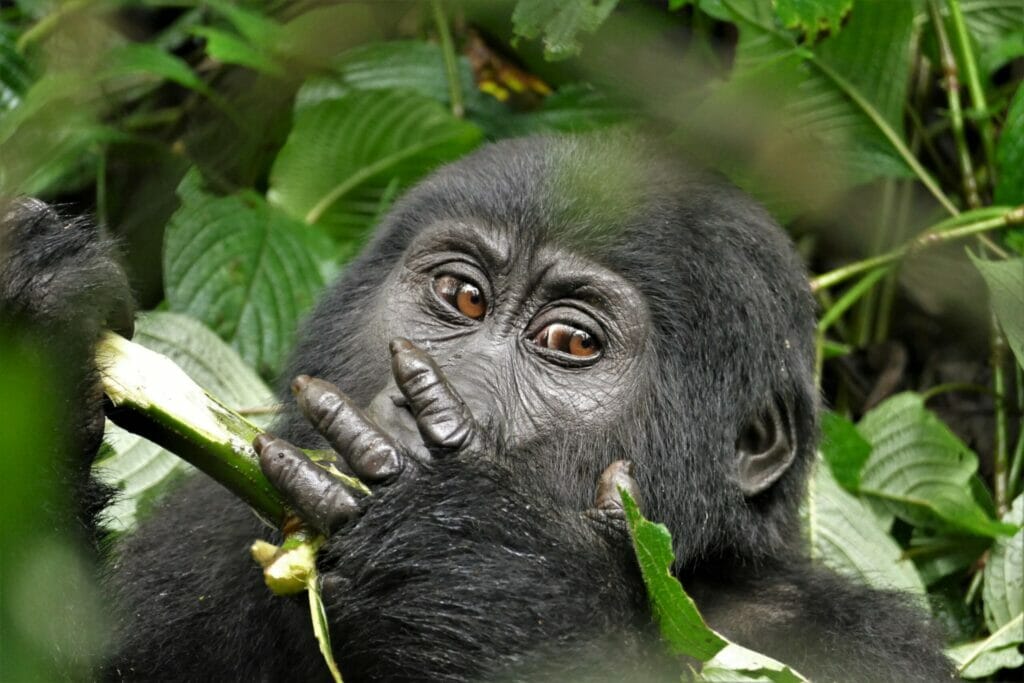
While gorilla trekking is an extraordinary experience, it is essential to be aware of potential challenges and risks that may arise during the trek. These challenges can include:
- Difficult Terrain: Gorilla trekking often involves navigating through dense forests, steep slopes, and sometimes muddy or slippery terrain. It is important to be prepared physically and mentally for these challenges and to follow the guidance of your guide.
- Altitude and Weather: Some gorilla trekking destinations are located at higher altitudes, which may cause altitude-related symptoms such as shortness of breath or fatigue. Additionally, weather conditions can change rapidly, and it is important to be prepared for rain or cooler temperatures.
- Encounters with Other Wildlife: While gorillas are the main attraction, it is common to encounter other wildlife during the trek, such as monkeys, birds, and various insect species. Your guide will provide guidance on how to interact with these animals respectfully and safely.
- Unpredictable Gorilla Behavior: Gorillas are wild animals, and their behavior can be unpredictable. While habituated gorillas are accustomed to human presence, it is important to always follow the guidelines provided by your guide and maintain a respectful distance to ensure the safety of both visitors and gorillas.
- Physical Fitness and Stamina: Gorilla trekking can be physically demanding, requiring stamina and endurance to navigate through challenging terrain. It is important to assess your fitness level and prepare accordingly to ensure an enjoyable experience.
By being aware of these potential challenges and risks and preparing adequately, you can minimize any potential difficulties and fully embrace the extraordinary adventure of gorilla trekking.
Other Wildlife Experiences and Attractions in Africa
While gorilla trekking is undoubtedly the highlight of any trip to Africa, the continent offers a wealth of other wildlife experiences and attractions that can complement your gorilla adventure. From encountering diverse wildlife species to exploring stunning national parks and engaging with local communities, Africa has something to offer every nature enthusiast. In this section, we will explore some of the additional wildlife experiences and attractions you can enjoy beyond gorilla trekking.
Additional Wildlife Encounters in Africa
Africa is renowned for its incredible biodiversity and the opportunity to witness a wide array of wildlife species in their natural habitats. Here are some remarkable wildlife encounters you can experience:
Big Five Safaris:
Embark on a thrilling Big Five safari to spot Africa’s most iconic and majestic animals—elephants, lions, leopards, buffalos, and rhinos. Several national parks and reserves in Africa, such as the Serengeti National Park in Tanzania, Kruger National Park in South Africa, and Masai Mara National Reserve in Kenya, offer exceptional opportunities for Big Five sightings. This is also possible in Uganda and Rwanda.
Primate Encounters:
In addition to gorillas, Africa is home to various primate species. Embark on primate tracking experiences to encounter chimpanzees, golden monkeys, baboons, and colobus monkeys. Destinations such as Kibale Forest National Park in Uganda, Nyungwe Forest National Park in Rwanda, and Mahale Mountains National Park in Tanzania offer unique primate encounters.
Safari Walks and Game Drives:
Explore the African wilderness on foot during guided safari walks, allowing you to discover the smaller details of the ecosystem and learn about the flora and fauna from knowledgeable guides. Alternatively, embark on thrilling game drives in open safari vehicles, providing excellent opportunities to spot a wide range of wildlife.
Bird Watching:
Africa boasts an incredible diversity of bird species, making it a paradise for birdwatchers. From vibrant African sunbirds to majestic raptors and iconic species like the African grey parrot, birdwatching enthusiasts can enjoy sightings in various habitats, including wetlands, savannas, and rainforests.
Cultural Experiences and Local Communities in Gorilla Trekking Destinations
Beyond wildlife encounters, Africa is rich in diverse cultures and vibrant local communities. Engaging with these communities can provide a deeper understanding of the region’s history, traditions, and way of life. Here are some cultural experiences to consider:
Village Visits:
Participate in village visits to learn about the local communities and their traditional practices. Interact with community members, witness traditional dances, and experience their daily lives. This provides an opportunity to support local economies and gain valuable insights into their unique cultures.
Cultural Festivals:
Attend cultural festivals celebrated by local communities, where you can witness traditional ceremonies, music, dance performances, and colorful displays of traditional attire. These festivals often highlight the rich heritage and customs of the communities.
Crafts and Art:
Explore local markets and workshops to discover traditional crafts and art forms. From intricate wood carvings to vibrant textiles and beadwork, these creations showcase the skill and creativity of local artisans.
Homestays:
Consider staying with a local family for a more immersive cultural experience. This allows you to engage directly with community members, learn about their customs, and contribute to the local economy.
By engaging in cultural experiences and supporting local communities, you not only gain a deeper appreciation for the region but also contribute to their sustainable development and preservation of their traditions.
Sustainable Tourism Initiatives in Gorilla Trekking Areas
Sustainable tourism is crucial for the long-term conservation of gorillas and their habitats. Many organizations and initiatives in gorilla trekking areas are dedicated to sustainable development, conservation, and community empowerment. Here are some examples of sustainable tourism initiatives in gorilla trekking destinations:
Community-Based Tourism Projects:
Several community-based tourism projects have been established to benefit local communities living near gorilla habitats. These initiatives provide alternative livelihood opportunities through activities such as cultural tourism, handicraft production, and guesthouse operations. By engaging in community-based tourism, you directly support local communities, contributing to their economic empowerment and reducing their reliance on activities that may harm gorillas and their habitats.
Conservation Education and Research:
Conservation organizations and research institutions conduct educational programs and research initiatives to raise awareness about gorilla conservation. These initiatives focus on educating local communities, visitors, and future generations about the importance of conservation and sustainable tourism practices.
Anti-Poaching and Wildlife Protection:
Efforts to combat poaching and protect gorillas and other wildlife are crucial for their survival. Many organizations collaborate with local communities and governments to implement anti-poaching measures, conduct patrols, and provide training and equipment to park rangers. These efforts help safeguard the gorilla populations and their habitats.
Responsible Tourism Practices:
Tour operators and lodges in gorilla trekking destinations play a vital role in promoting responsible tourism practices. They adhere to strict guidelines to minimize the impact on gorillas and their habitats. These guidelines include limiting the number of visitors, maintaining a safe distance from gorillas, and ensuring proper waste management and sustainability practices.
By supporting these sustainable tourism initiatives, you contribute to the long-term conservation of gorillas and their habitats, while also helping to improve the livelihoods of local communities.
In the next section, we will provide tips for extending your trip and exploring Africa further, allowing you to make the most of your visit to this remarkable continent.
Book Your Mountain Gorilla Trekking Tour With Kikooko Africa Safaris
Want to learn more about mountain gorilla trekking? Feel free to contact the team at Kikooko Africa Safaris to get a suggested itinerary, check about permit availability, and more!


